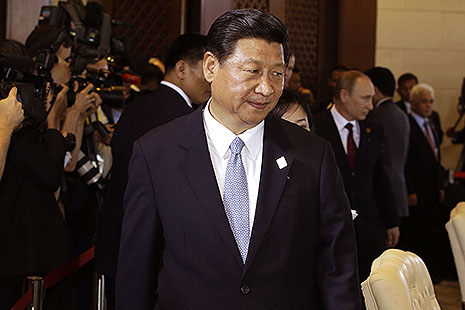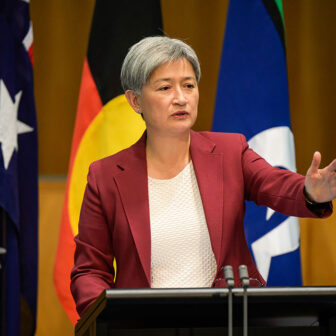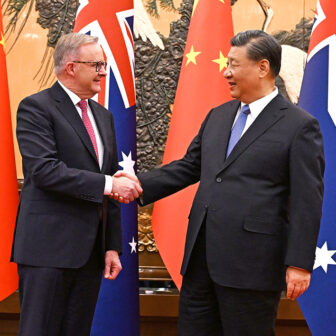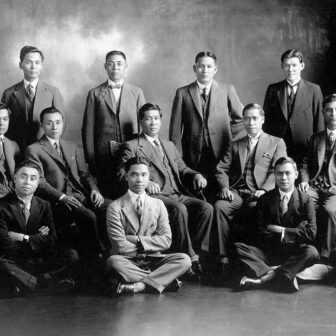Stumbling Giant: The Threats to China’s Future
By Timothy Beardson | Yale University Press | $45
As a historian, I was once invited to an event in China marking the contributions of Chinese students and researchers who had returned to their homeland since the founding of the old Republic in 1912. The event was at a time of high tension in China over contested islands in the South China Sea.
A speaker affiliated with the People’s Liberation Army, or PLA, took to the stage and recited a list of the significant achievements of returned students, including the indigenous grafting of nuclear and missile technologies from the United States and the former Soviet Union, before pointing with dismay at the restrictions some countries now placed on the transfer of sensitive technologies.
He called for renewed efforts by Chinese researchers going abroad to acquire new skills and technologies despite the obstacles placed in their way. Then, straying from his notes, he turned to the audience of historians and education experts with an off-the-cuff remark. Concerned citizens often asked him why the PLA did not simply go out and seize China’s sovereign territories in the South China Sea, he said. He cautioned patience. China was not quite ready to take the islands by force. The country needed to upgrade its scientific technology and military preparedness before taking such a course. This was the challenge facing the generation of Chinese students and scholars going abroad to study and do research – to bring back new knowledge and new technologies to help China realise its dream of national revival.
The PLA has its own peculiar take on things, and the off-hand views of its public spokesmen don’t always reflect those of central party and government authorities. In fact, the official goal of China’s science and technology policy is not to prepare for war in the neighbourhood but to “accelerate the transformation of economic development – the first priority of the national strategy.” The challenges facing sustainable economic development in China also warrant every ounce of innovation the country can squeeze out of its strategic investments in cutting-edge science and technology.
Still, any perspective on China’s national science and technology policy from the PLA – a powerful institution with a role in policy-setting and implementation – needs to be taken seriously. A little reflection on the way China approaches and polices research in the sciences, including the social sciences, suggests that an old-fashioned national security agenda, fuelled by historical grievances, is an important part of China’s national science policy.
China’s knowledge economy is a powerful but brittle thing. It is powerful in its single-minded strategic pursuit of national security and development and yet fragile for much the same reason. In Stumbling Giant: The Threats to China’s Future, strategic thinker Timothy Beardson notes that China, rather than investing in open-ended critical inquiry and experimentation of the kind that stimulates innovation, invests strategically in national development and defence and then steals what it cannot discover or invent. This dual approach is strategic in the very old sense that it centres on winning through deception, a strategy often associated with that overrated text, Sun Tzu’s Art of War, and mistaken for mainstream strategic statecraft in China. Together, the single-minded pursuit of national security and the inclination to advance by stealth make China’s knowledge economy a powerful and at the same time brittle thing.
The strategy has paid huge dividends. China’s digital penetration programs have largely neutralised the historical advantage the United States has enjoyed in important industrial and militarily sensitive technologies. In the longer term, however, China’s disregard for open and honest inquiry of the kind that fosters critical thinking could mean the national educational and research effort will continue to be beset by plagiarism, copy-cat patents, and sham research outputs serving personal and national ambitions. In China’s case, a strategic approach to science research could well advance the country’s strategic objectives while doing little to advance science.
Beardson’s wide-ranging and engaging tour de force covers topics well beyond science, technology and hacking, in a volume that runs to over 500 pages. The overarching question that frames the book is if, when and how China will replace the United States as the world’s dominant superpower. This is not a question that will engage all readers; nor, strictly speaking, is it one that can be answered by probing China’s challenges and achievements alone. The United States could conceivably fall behind China by failing to deal with its own home-grown problems without China lifting a finger. What makes the book engaging is Beardson’s methodical focus on the weaknesses and challenges that are holding China back from realising its potential, with or without America. The country’s leaders are simply too prone to outlawing free and open critical thinking of the kind that promotes innovation and knowledge creation on the scale necessary for China to meet the serious challenges ahead.
After reviewing China’s responses to these challenges to date, Beardson concludes China will not overtake the United States any time over the coming century. On the macro level, he takes issue with economic historians who claim China is re-emerging to reclaim its rightful place in history. He takes on champions of linear development who confidently extrapolate current trends to predict when and how China will conquer the world. China never was what it is now made out to be, he suggests, and is far from being what it may yet become. On the micro level, the book focuses on the principal challenges to China’s continuing development, including environmental, welfare, demographic, economic, financial, political and challenges, in addition to persistent challenges to the knowledge economy of education and research in the sciences and social sciences.
As a science latecomer, China finds the odds stacked against it. The barriers facing Chinese researchers wishing to publish in high-impact journals are formidable. Citations of mainland authors in the Thomson Reuters Science Citation Index have almost quadrupled over the past decade but the contribution ratio of articles published in China’s own journals has halved over the same period. Indeed, less than 1 per cent of articles by Chinese researchers appearing in the highly cited Thomson Reuters Essential Science Indicators over the past decade initially appeared in China. So China’s national research strategy is designed partly to meet the catch-up challenge of accessing refereed journals in English.
In order to enhance the country’s research impact, the communist government has made a strategic investment in launching more than 200 academic titles in English. Four in five of these titles are produced in association with academic publishers, including Emerald, Taylor & Francis/Routledge, Oxford, Elsevier, Brill, and Springer, and virtually all claim to ascribe to the standards of peer review. Emerald’s China series, Brill’s Frontiers series of China-based journals, Oxford’s Chinese Journal series, and Taylor & Francis’s China-based social science journals typically carry claims that “research articles in this journal have undergone rigorous peer review” under the expert direction of the Chinese institution sponsoring the journal. On their websites, the sponsoring organisations typically profess allegiance to the unchallengeable leadership of the Communist Party and to its Four Cardinal Principles of socialism, proletarian dictatorship, Marxism, and Mao Zedong Thought. Each of the journals claims to be refereed according to the norms of peer review but all are ultimately policed for compliance with these principles by the Communist Party secretary of the sponsoring institution in China.
To launch a new journal in association with a respected publishing house, a Chinese academic publisher must obtain registration approval from national party authorities, which brings with it strict controls over content and process. This is reflected in their content. Browsing through titles in government-sponsored humanities and social sciences series published in new-style refereed journals published by Oxford, Taylor & Francis, Brill and so on, readers will search in vain for articles offering impartial, let alone critical, perspectives on the role of the Chinese Communist Party or the People’s Government. All comply with the Four Cardinal Principles.
These refereed journals also display a consistent party line on core issues of national sovereignty involving Taiwan, Tibet, Xinjiang and contested maritime territories in the seas along China’s coast, all of which are open for partisan advocacy but none for challenging research. This is not surprising given they are policed by the party and the bulk of competitive research grants in the social sciences are funded by a strategic arm of the Communist Party’s Central Propaganda Bureau known as the Social Sciences Foundation. Partiality is a condition both of funding and of publication.
Selective partiality is not uncommon among Western political magazines, but few of these claim to be ly refereed academic journals. Journals of opinion such as Commentary or New Left Review occasionally present outstanding research – just as China-based peer-review journals do – but they are read and recognised as journals of opinion. The system of blind refereeing was naively imagined as separating these journals from academic research publications. The system is not perfect. In the United States, journal editors complain that scientific research publications are compromised by powerful Western drug companies. Social science journals face similar risk of compromise in the face of China’s strategic interventions in research publication.
China’s approach to research in the humanities and social sciences also tests the bona fides of the academic publishers hosting the hundreds of China-based journals that have appeared in recent years. In addition to taking core issues of national sovereignty off the table, Chinese authorities periodically ban discussion of other issues that are at the heart of research in the humanities and social sciences. Earlier this year, central party officials added seven subjects to the list of taboo topics never to be mentioned in college cafes or university classrooms, let alone to appear in academic print. These include freedom of speech, judicial independence, civil society, civil rights and universal values, as well as criticism of the Communist Party and allusions to its privileged, wealthy leadership.
Over the months since the list was promulgated, important books in the social sciences and humanities have been dumped, and journal articles dropped, because they happened to touch on constitutional government, or judicial independence, or the formation of civic associations. Websites and e-newsletters have been shut down and their editors locked away on trivial charges for allegedly ignoring the bans. This style of attack on fundamental research in the humanities and social sciences tests the resolve of academic publishers operating under rule of law in liberal democratic jurisdictions guaranteeing their freedom to publish China-based refereed academic journals that are themselves not permitted to mention the conditions that make their publication possible abroad.
A number of these issues have real-world implications. Take history, for example. China’s territorial claims against Vietnam, the Philippines, Malaysia and other littoral states in the South China Sea pale alongside its robust challenge to Japanese sovereignty over the Senkaku/Diaoyu island chain. China’s claims against Japan are fuelled by historical memories that challenge the postwar order in the Asia-Pacific region.
In the West we are accustomed to thinking of the Pacific war as ending with Japan’s formal surrender on the USS Missouri in September 1945. But that was just the Pacific war. China’s immediate war with Japan began with the Japanese imperial army’s invasion of Manchuria a decade before the attack on Pearl Harbour, and its longer war began with Japan’s colonisation of Taiwan and adjacent islands – including the Senkaku/Diaoyu islands – in 1895. For many people in China, including a new generation of senior leaders, this war against a brutal Japanese invasion did not end on the decks of the USS Missouri. It is still under way and awaiting a long-overdue victory.
China’s long war with Japan is played out daily on national television. More seriously, senior figures encourage ordinary citizens in the belief that the government is “hiding its capacity and biding its time” while marshalling resources to inflict the long-overdue defeat. Last year, one Melbourne-based Chinese businessman put it to me this way: “You Westerners just don’t get it. In east Asia we share a common sense of history and culture. Our shared history goes back a long way, as the Japanese well know. They invaded us and we have to teach them a lesson. That’s just the way it is. Either they surrender, or we go to war. I give them five years to decide.”
Authorities encourage people in these beliefs. Over a season of festive anti-Japanese riots in China, I got to talking with Beijing locals about whether they thought an outbreak of hostility between China and Japan was inevitable. The typical answer went something like this: “Well, not in the next five years perhaps, but a fight with Japan is probably inevitable. It may take ten or twenty years. It’s inevitable because the Japanese simply cannot accept China’s national revival. They can’t live with it.”
That revival has been elevated to a transcendent goal for all national strategy in China following the recent ascent to leadership of president Xi Jinping. It is enshrined in the phrase “China Dream.” On assuming office in China, each new leadership group since Mao Zedong has selected a title or phrase to capture the distinctive policy emphasis that marks its ascendance. For Deng Xiaoping the phrase was Opening and Reform, for Jiang Zemin it was the Three Represents, for President Hu Jintao it was the Scientific Outlook on Development. The reign title for President Xi Jinping is still under negotiation but the phrase China Dream is a serious contender.
The custom of selecting a visionary title for each leadership group mirrors earlier patterns of dynastic succession, when succeeding emperors of China selected a title for their period of rule, such as Glorious Way or Forever Righteous. The sequence of titles supports the claim of each succeeding regime to legitimate succession and demonstrates the consistency of its policy innovations with earlier practices.
Even China’s official national science policy follows this formula, with its text professing to “follow the guidance of Deng Xiaoping Theory and the important thought of Three Represents, and thoroughly apply the Scientific Outlook on Development.” Like the titles that immediately preceded it, Xi’s China Dream will hold public attention for the duration of his term in office before being buried as a phrase in the order of legitimate succession by his successor. China has just ten years to realise his dream.
On one reading, the vision of “national revival” underlying Xi Jinping’s China Dream is a potent military and strategic one. Xi borrowed the phrase from the title of a 2010 book by senior PLA commander Liu Mingfu, China Dream: Great Power Thinking and Strategic Positioning of China in the Post-American Age. The book was widely promoted by military bureaucrat Liu Yuan, the son of former president Liu Shaoqi and a princeling ally of Xi Jinping, in the year Xi assumed the post of Communist Party chairman.
There were explicit messages for Australia in this. In an interview with Fairfax journalist John Garnaut, author Liu Mingfu referred to the United States and Japan as “tigers and wolves” encircling China. Liu advised Australia not to play jackal to Japan’s wolf and implied that after the bombing of Darwin during the second world war, Australians must surely harbour lingering hatred against Japan similar to that felt by people in China. So, Liu claimed, the world would applaud if Japan were knocked out with another nuclear bomb.
For Australians this is a frightening vision. Granted, something like this was to be expected once the instinct towards anti-foreign nationalism became a default position in Chinese public life. Blaming foreigners for everything nasty and claiming credit for everything decent has been the Communist Party’s modus operandi since the 1990s. Some people in China say we shouldn’t overreact to the militant nationalism of Xi Jinping’s China Dream because it is likely to prove little more substantial than the hot air that preceded it. And yet there seems little doubt that China’s ambition for national revival is shaping the country’s national research strategy. A quiet but concerted campaign of intimidation is currently under way in China’s universities, research institutes and public media, aimed at rooting out anyone likely to question this strategy. Sceptics and critics are staying low to avoid disgrace, demotion or arrest. It’s all part of the strategy.
Chief scientist Ian Chubb recently called on Australia to adopt a strategic approach to scientific research of the kind that has catapulted China into second place in the scientific league table. On some estimates, China is poised to overtake the United States as top science producer by 2020. Chubb urges Australia to lift its game by following in China’s path and becoming more strategic in aligning its research funding with the country’s strategic objectives and the great societal challenges we face. And we could meet these challenges more successfully if we engaged more closely with China.
Like people in China, Australians want to ensure that our limited research resources are well spent. But do we share the same vision of what research is all about?
Every national research strategy serves a higher vision that guides selection of programs and objectives for investment. This is true for Australia no less than for China. In wartime, as a rule, Australia’s science and technology workforce shows little hesitation in putting its shoulders to the wheel in the service of the nation. Any country under attack expects its national leaders to come up with strategies and tactics to prosecute war, to mobilise available resources, and to allocate resources to align research efforts with strategies to emerge victorious.
In peacetime, research tends to be driven by curiosity. Postwar Australian governments have periodically supported research institutes serving particular areas of national need including agriculture, animal husbandry, industry, health, the environment, and so on. But outside of war the majority of the country’s workforce in universities and academies generally moves in sympathy with peer research, at the cutting edge of discovery and design, rather than heeding government strategies for prioritising research questions and projects. This is not to say that governments should not try to align research resources with strategies, but they do need to acknowledge that strategic science is not always good science and that good science is not always strategic.
China has a clear and effective research strategy for the simple reason that it imagines it is still at war. In the old Republic, before the communists came to power in 1949, China supported a small liberal research establishment. Under the communists, however, the strategic vision driving China’s research efforts in sciences, technology, engineering, medicine, and the social sciences and humanities has been a persistent wartime vision. Since 1949 it has been driven first by class war, then by the demands of postwar development, and most recently by the China Dream of national and military rejuvenation. China is in little doubt about the dream that drives its science strategy. Australians would do well to consider whether they share that dream before aligning the country’s national research strategy too closely with China’s.
Given these diverging goals and approaches, what would constructive research collaboration between Australia and China look like? We could focus, as Chubb suggests, on areas of research where we share common interests. One area lies in developing a common evidence-based approach to the big societal challenges that the two countries confront together in the Asia-Pacific region. Beardson’s relentless tabling of problems confronting China in the coming decade can be reduced to a small number of key societal challenges that overlap on some points with Australia’s own strategic research priorities.
One cluster of problems Beardson identifies is economic and financial. To engineer a shift from a low-cost, labour-intensive, export-driven economy to a dynamic domestic economy and a value-added export economy, China needs to figure out how to manage local government debt, mobilise domestic savings, and liberalise financial markets, among other things. Another set of challenges is demographic, including a declining labour force and rapidly ageing population alongside a disturbingly high percentage of males who will never be socialised through marriage. A third is social stability. China needs to redress the imbalance between resources allocated to policing social dissent relative to those allocated to social welfare and health and human service provision to ensure sustainable social development.
A fourth cluster of challenges relates to energy and natural resources, including a frightening rise in ecological damage to soil, water and air, a dependence on dirty energy, and difficulty of access to increasingly remote energy and mineral resources. A fifth cluster circles around China’s domestic governance and relations. Few of these challenges will be met if China carries on deploying labour-intensive industries to penetrate global consumer markets in order to enrich a small number of people and industries enjoying privileged access to power.
A sixth challenge is developing China’s growing knowledge economy to the point where it can help meet each of the other challenges. This is where research collaboration could make a difference. And yet the different value Australia places on free and open critical inquiry is an obstacle both to the development of China’s knowledge economy and to effective bilateral research collaboration.
As Beardson remarks, one of the ongoing effects of China’s highly focused research strategy has been to outlaw free and open critical thinking on a scale that would promote innovation and knowledge creation of the problem-solving kind. Given these constraints, China and Australia need to think outside the square if they are to meet common challenges in a spirit of collaboration. For China, this could mean opening its knowledge economy to critical thinking in the humanities and social sciences in addition to science and technology. As Beardson concludes, “it is difficult to have ‘critical thinking’ in science if it is banned in history and politics.”
For Australia, it could mean helping China to do this by supporting co-development of critical thinking skills in the humanities and social sciences, by focusing collaborative discussions on our respective research cultures, and by building basic information infrastructure that is open and accessible to all. We would need to show by example that we do not countenance partisan political interference in the management of our own grants system for the humanities and social sciences.
Australia could also focus on specific questions underlying China’s historical grievances. Why do that country’s memories of war with Japan, a war we prosecuted together as allies from 1941 to 1945 when China was under the Nationalist Government, differ so markedly from our own? People in Australia need to understand the sources of China’s grievances before we can work productively to address them. This could be good for the sciences and for the humanities, good for China and Australia, and good for continuing peace and stability in the Asia-Pacific region.
Finally, as Australians learn to be more strategic in our research funding and research collaborations, they could work to encourage China’s policy planners to be less strategic in the way that they guide, reward, and police their national research effort.
Australia could start the formal conversation by asking why no one in China can access or read chief scientist Ian Chubb’s plea for closer research ties between our two countries. At the time of writing, the website of the Australian Chief Scientist’s Office was blocked in China. •




